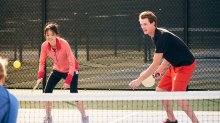How Schools Are Reframing Gym Class to Be More Engaging
A series of small shifts can make physical education more welcoming and help reluctant students warm up to the idea of getting and staying active.
Your content has been saved!
Go to My Saved Content.For many students, gym class is a difficult part of the school day. As carefree recess and unstructured opportunities to run and play are replaced in the higher grades with required physical education and structured competitive team sports, kids can develop strong negative feelings about exercise.
“My hate for gym class is strong. I don’t care if I have to skip that class all year! I am not going,” wrote one student on Twitter. “I hate gym class, literally why is this mandatory?” said another.
Students’ attitudes toward PE, writes Linda Flanagan in an article for KQED, can involve a complex mix of emotions. “The humiliation of being passed over when kids pick teams; the awkwardness of having to socialize with strangers from different grades; the Hobson’s choice of either undressing and showering in front of peers or returning to class in sweaty clothes,” writes Flanagan. “All these features of physical education contribute to kids’ discomfort.”
A 2022 report from the Aspen Institute's Sports & Society Program found that less than four in 10 high school students participate in sports—and fewer than 25 percent meet the recommended level of daily physical activity. And while 66 percent of ninth-grade students did PE at least once a week thirty years ago, that number dropped to just 35 percent in 2019.
Meanwhile, a growing body of research links physical activity to academic achievement and overall well-being: Exercise helps ward off common teenage stressors like anxiety and depression—which can derail even the most well-adjusted students—and improves memory and concentration. Even a single session of moderate physical activity, according to a 2016 research statement from The Copenhagen Consensus Conference, can deliver "an acute benefit to brain function, cognition and scholastic performance," reports Bryan Toporek for Education Week.
Keenly aware of the benefits of physical activity, and in spite of budget and space constraints, some schools and teachers are rethinking gym class, with a goal of increasing participation and acquainting students with movement in ways that feel enjoyable and sustainable.
Get Student Input: To get a baseline read on where students are at, consider asking for their input via a brief survey. “Bolster [the survey] with questions that tease out insights that include but are not limited to gender interests,” notes the Aspen Institute report and allow for “analysis by disability, race or ethnicity, and grade level.” Ask students which sports they’d like to play, what their other health and fitness interests and goals are, and “why they play and why they don’t.”
Make Locker Rooms Safer: Locker rooms can be a place of judgment and fear for students. To accommodate those who feel uncomfortable changing in front of peers—no matter the reason—Howard Putterman, athletic director at Tuscarora High School in Frederick, Maryland, encourages some kids to use the locker room earlier, “ahead of the crowd," Flanagan writes. Additionally, students are still able to participate whether they change clothes for PE or not. To further preempt bullying, school leaders should review, update, and vigilantly enforce policies that prohibit appearance-related teasing and body shaming, providing support for students who may be affected.
Keep It Fresh: To pique and keep kids’ interest, PE instructors at A.D. Henderson University School in Boca Raton, Florida, change up units every two to three weeks. Students are exposed to new sports options like pickleball, for example, and in some cases instructors get creative, inventing new games for students to play, which levels the playing field, Flanagan reports. “Even the most experienced athletes, then, have to learn these games from scratch.” And on "free-day Fridays" at Tuscarora High, students get to decide among themselves which activity they'll engage in during gym period, giving them a bit of choice and agency in the matter.
Occasionally Put Kids in Charge: In an intentional move to strengthen team bonds, while building students’ social and collaborative problem solving skills, Massachusetts PE teacher Adam Hughes forms small groups and asks each group to lead a lesson, once per class cycle. “The teams must collaborate to find lesson materials, plan an entire lesson, and execute it with a larger group,” writes Doug Curtin, a director of content and curriculum. “After teaching the class, the leaders must practice empathy and patience when introducing a new topic to other students.”
Provide Intensity Options: Not all kids want to compete, Flanagan writes, but providing opportunities for intense or relaxed play—during PE or after-school intramurals and club teams—creates a bridge for reluctant students to participate without fear of aggressively competitive peers or keeping the team from the championship trophy. “Kids who want to go hard at the game can compete against other gung-ho players, while those who prefer a relaxed and fun approach can participate with similarly mellow students,” she explains.
Untether Exercise From Punishment: Avoid using physical exercise as a form of discipline for minor infractions like tardiness or misbehavior, it's counterproductive to the goal of showing kids the joys of movement, Chris Childs, the athletic director at A.D. Henderson University School tells Flanagan. His class begins when students have changed clothes, with Childs taking attendance as students walk the gym’s perimeter. "Sentencing the tardy student to three laps around the field won’t teach kids that exercise can be enjoyable," Flanagan says.
Partner With the Community: Many schools lack a dedicated physical fitness space like a gym, playground, or even a full-time, certified PE teacher. Reaching out to community groups like the YMCA and the Boys & Girls Club to develop shared-use agreements can provide much-needed space, equipment, and instructors, Flanagan suggests. Additionally, consider contacting organizations like the Special Olympics or Soccer Without Borders to inquire about the donation of used gym equipment.
